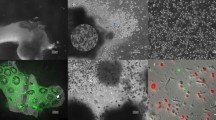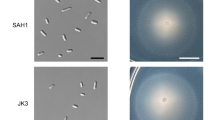Abstract
Dictyostelium discoideum, a unicellular organism capable of developing into a multicellular structure, is a powerful model system to study a variety of biological processes. Because it is inexpensive and relatively easy to grow, Dictyostelium is also frequently used in teaching laboratories. Here we describe conditions for successfully growing and developing Dictyostelium cells and methods for long-term storage of Dictyostelium amoebae and spores.
This is a preview of subscription content, access via your institution
Access options
Subscribe to this journal
Receive 12 print issues and online access
$259.00 per year
only $21.58 per issue
Buy this article
- Purchase on Springer Link
- Instant access to full article PDF
Prices may be subject to local taxes which are calculated during checkout




Similar content being viewed by others
References
Parent, C.A. Making all the right moves: chemotaxis in neutrophils and Dictyostelium . Curr. Opin. Cell Biol. 16, 4–13 (2004).
Van Haastert, P.J. & Devreotes, P.N. Chemotaxis: signalling the way forward. Nat. Rev. Mol. Cell Biol. 5, 626–634 (2004).
Manahan, C.L., Iglesias, P.A., Long, Y. & Devreotes, P.N. Chemoattractant signaling in Dictyostelium discoideum . Annu. Rev. Cell Dev. Biol. 20, 223–253 (2004).
Titus, M.A. The role of unconventional myosins in Dictyostelium endocytosis. J. Eukaryot. Microbiol. 47, 191–196 (2000).
Maniak, M. Conserved features of endocytosis in Dictyostelium . Int. Rev. Cytol. 221, 257–287 (2002).
Williams, H.P. & Harwood, A.J. Cell polarity and Dictyostelium development. Curr. Opin. Microbiol. 6, 621–627 (2003).
Chisholm, R.L. & Firtel, R.A. Insights into morphogenesis from a simple developmental system. Nat. Rev. Mol. Cell Biol. 5, 531–541 (2004).
Eichinger, L. et al. The genome of the social amoeba Dictyostelium discoideum . Nature 435, 43–57 (2005).
Chisholm, R.L. et al. dictyBase, the model organism database for Dictyostelium discoideum . Nucleic Acids Res. 34, D423–D427 (2006).
Sussman, R. & Sussman, M. Cultivation of Dictyostelium discoideum in axenic medium. Biochem. Biophys. Res. Commun. 29, 53–55 (1967).
Watts, D.J. & Ashworth, J.M. Growth of myxameobae of the cellular slime mould Dictyostelium discoideum in axenic culture. Biochem. J. 119, 171–174 (1970).
Ashworth, J.M. & Watts, D.J. Metabolism of the cellular slime mould Dictyostelium discoideum grown in axenic culture. Biochem. J. 119, 175–182 (1970).
Iranfar, N., Fuller, D. & Loomis, W.F. Genome-wide expression analyses of gene regulation during early development of Dictyostelium discoideum . Eukaryot. Cell 2, 664–670 (2003).
Van Driessche, N. et al. A. Transcriptional profile of multicellular development in Dictyostelium discoideum . Development 129, 1543–1552 (2002).
Franke, J. & Kessin, R. A defined minimal medium for axenic strains of Dictyostelium discoideum . Proc. Natl. Acad. Sci. USA 74, 2157–2161 (1977).
Sussman, M. Biochemical and genetic methods in the study of cellular slime mold development. in Methods in Cell Physiology Vol. 2 (ed. Prescott, D.) 397–410 (Academic Press, New York, 1966).
Gaudet, P., Pilcher, K.E., Fey, P. & Chisholm, R.L. Transformation of Dictyostelium discoideum with plasmid DNA. Nat. Protoc. 2, 1317–1324 (2007).
Pilcher, K.E., Gaudet, P., Fey, P., Kowal, A.S. & Chisholm, R.L. A reliable general purpose method for extracting RNA from Dictyostelium cells. Nat. Protoc. 2, 1329–1332 (2007).
Pilcher, K.E., Fey, P., Gaudet, P., Kowal, A.S. & Chisholm, R.L. A reliable general purpose method for extracting genomic DNA from Dictyostelium cells. Nat. Protoc. 2, 1325–1328 (2007).
Raper, K.B. Growth and development of Dictyostelium discoideum with different bacterial associates. J. Agric. Res. 55, 289–316 (1937).
Hughes, J.E., Podgorski, G.J. & Welker, D.L. Selection of Dictyostelium discoideum transformants and analysis of vector maintenance using live bacteria resistant to G418. Plasmid 28, 46–60 (1992).
Bonner, J.T., Davidowski, T.A., Hsu, W.-L., Lapeyrolerie, D.A. & Suthers, H.L.B. The role of surface water and light on differentiation in the cellular slime molds. Differentiation 21, 123–126 (1982).
Sussman, M Cultivation and synchronous morphogenesis of Dictyostelium under controlled experimental conditions. in Methods in Cell Physiology Vol. 28 (ed. Spudich, J.) 9–28 (Academic Press, New York, 1987).
Acknowledgements
We thank Geraldine Amargo for her advice in preparing this manuscript. dictyBase (http://www.dictybase.org) is supported by grants from the NIH (GM64426 and HG00022).
Author information
Authors and Affiliations
Corresponding author
Ethics declarations
Competing interests
The authors declare no competing financial interests.
Rights and permissions
About this article
Cite this article
Fey, P., Kowal, A., Gaudet, P. et al. Protocols for growth and development of Dictyostelium discoideum. Nat Protoc 2, 1307–1316 (2007). https://doi.org/10.1038/nprot.2007.178
Published:
Issue Date:
DOI: https://doi.org/10.1038/nprot.2007.178
This article is cited by
-
Scale-up of an amoeba-based process for the production of the cannabinoid precursor olivetolic acid
Microbial Cell Factories (2022)
-
Fractional 2′-O-methylation in the ribosomal RNA of Dictyostelium discoideum supports ribosome heterogeneity in Amoebozoa
Scientific Reports (2022)
-
Engineering the amoeba Dictyostelium discoideum for biosynthesis of a cannabinoid precursor and other polyketides
Nature Biotechnology (2022)
-
A ‘dynamic adder model’ for cell size homeostasis in Dictyostelium cells
Scientific Reports (2021)
-
A lysosomal enigma CLN5 and its significance in understanding neuronal ceroid lipofuscinosis
Cellular and Molecular Life Sciences (2021)
Comments
By submitting a comment you agree to abide by our Terms and Community Guidelines. If you find something abusive or that does not comply with our terms or guidelines please flag it as inappropriate.



